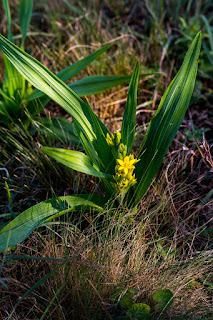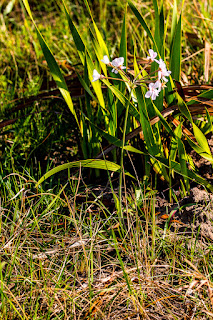As it was close to the time of year for our annual hunt for Euphorbia bupleurifolia plants, we headed off to the recently burned portion of the Western Heights to see what had emerged since the burn some two weeks earlier. We know enough not to expect much so soon after a burn but some species emerge so quickly that delaying much longer would likely mean we would miss their flowering.
After battling along the track to the Western Heights - several small trees had blown across the track requiring some teamwork to get the obstacles out of the way - we parked and started walking towards the burned areas. Soon we were passing the delicate nodding heads of Disa baurii protruding above the unburned grass.
 |
| Discussing how to move a fallen tree (Photo: Gail B-W) |
 |
| Disa baurii |
Once we reached the edge of the burn we set off across the stream and wetland. It was not long before we were finding
Cyrtanthus breviflorus. When this species grows in a wetland, it is anything but short and we could see many of these robust stalks. Many had already finished flowering. It is amazing how quickly these plants respond to a well-timed burn. Also present in numbers and growing in clumps were
Gerbera kraussii - now sunk into the dumping ground of
Gerbera ambigua.
 |
| The wetland form of Cyrtanthus breviflorus |
 |
| Gerbera kraussii - now sunk into Gerbera ambigua |
 |
| An emerging bud of Gerbera krausii |
 |
| An emerging bud of Merwilla plumbea seeing the light of day for the first time |
Once we had staggered through the heavily tussocked wetland, we emerged onto more even dry ground and started seeing little yellow flashes of
Gazania krebsiana, many of which were flowering in an almost leafless state. We were lucky to catch a Gaudy Commodore butterfly sating itself on nectar from these flowers.
 |
| Gazania krebsiana |
 |
| A Gaudy Commodore visiting a Gazania krebsiana |
After searching for some time, Anne's shout alerted us and we walked over to see the first of the
Euphorbia bupleurifolia plants of this season. When the veld is freshly burned, these plants are very obvious but once the grass and other forbs grow back, they
are very hard to find. Here we also found the first of the
Othonna natalensis buds.
 |
| One of the many Euphorbia bupleurifolia |
 |
| Othonna natalensis bud |
We walked on towards the Umtamvuna River gorge passing through an area where there were many dead stalks of small
Protea caffra shrubs. Their dead flower heads shone in the winter sun and the ground was littered with their seeds. Gail and Tracy posed several rodent skulls on a bed of these seeds.
 |
| Rodent skulls on a bed of Protea seeds - sounds like a restaurant menu item (Photo: Gail B-W) |
 |
| The remnants of a Protea caffra inflorescence |
 |
Just a bit more effort will do it! (Photo: Gail B-W)
|
We had our lunch perched above the Umtamvuna gorge and then worked our way around a hillock heading back towards the vehicles. There was a rather unusual rock sculpture at the top of the hill. As we walked on we came across several more
Euphorbia bupleurifolia plants. Clustered in a crack in a rock outcrop was a small clump of
Albuca setosa with emerging buds.
 |
| An agonised face sculpted in the rock |
 |
| Straggling on the way home |
 |
| Posed in front of the imposing cliffs above the Umtamvuna River |
 |
| Albuca setosa buds |
Participants: Alf H, Anne B-W, Anne S, Gail B-W, Graham G, Kate G, Maggie A, Mark G, Tracy T.











































































































